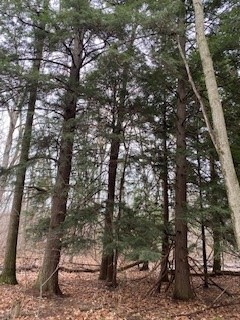Hemlock
Garden Clippings Dec 17, 2022
A rare phenomenon is growing alongside the Upper Ridge portion of the Heart of the Trails walking path in Port Franks. Most wouldn’t notice, but there is a cluster of mature Canadian Hemlock trees growing in the bush that is otherwise dominated by Oaks and other Carolinian trees.
Canadian Hemlock (Tsuga Canadensis), also called Eastern Hemlock is a native Canadian conifer growing in forests in southwest Ontario, eastward to the Maritimes, and south almost reaching Florida. In mid-Eastern USA, Hemlocks grow to become monsters, but here in Lambton County I have rarely seen Hemlocks grow larger than 5 to 10 metres.
Not the Hemlocks at Port Franks. This group of about 15 Hemlocks is growing as high as the rest of the forest, with a trunk diameter as large as telephone poles. This strange phenomenon can only be explained by suggesting that their growing conditions are perfect for extraordinary growth.
Hemlocks like well drained soil, of which there is plenty in the sand dunes along these parts of Lake Huron. Hemlocks like partial shade, making the tall adjacent Oaks perfect companions. And Hemlocks thrive where there is some wind protection, deep in the woods of the forest.
But oddly enough, Hemlocks are not drought tolerant so supposedly the sandy soil in Port Franks would not bode well for Hemlocks. We know sand has little water holding capacity, and we also know the water table in Port Franks is low. The nearby Thedford bog’s elevation is much lower than the sand dunes of Port Franks.
No doubt, years and decades of leaf accumulation has bult up sufficient mulch to keep soil moist under the monster sized Hemlock.
Hemlocks are the only native conifer that enjoys shady conditions. While they prefer some sun, Hemlocks will survive in nearly deep shade.
Hemlocks are a good choice for home gardens because they do not grow as large as native Pine and Spruce varieties. And if Hemlocks grow too large for our liking, they can easily be trimmed to keep down to size.
Needles of Hemlock are tiny and arranged in flat sprays, resulting in a fine textured, soft, and graceful, appearance. Needle colour is rich green, with little loss of colour through winter.
The most significant growth requirement for Hemlock is their need for well drained, moist soil. They will benefit from a weekly drink, particularly through the dry summer months. If planting Hemlock in clay soil, plant high so excess water runs away. Hemlock does not like to be waterlogged.
Finally, Hemlocks will thrive if their roots are covered with a thick layer of organic mulch. Use leaves, woodchips, or cedar mulch in a 5 or 6 ft diameter circle, and add top up with new mulch every few years.


